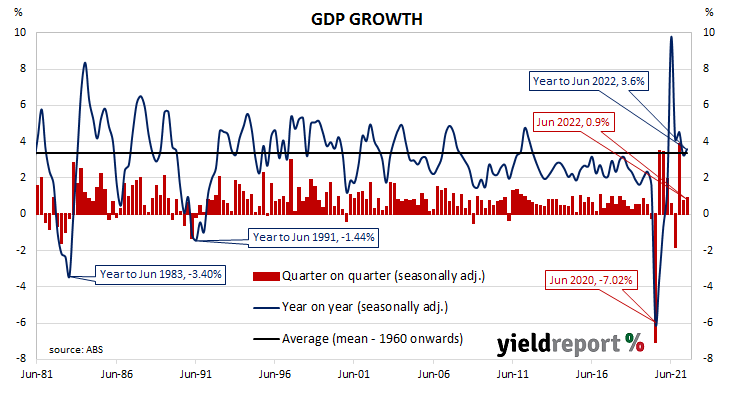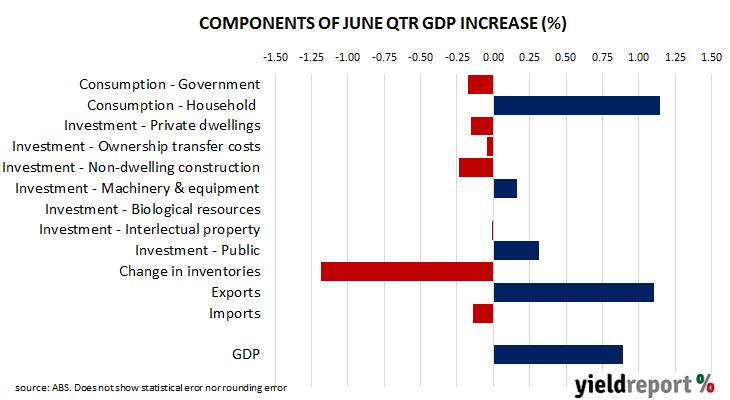Summary: Australia’s GDP up 0.9% in June quarter, less than expected; biggest surprise from consumer spending; shows little impact of rate hiking cycle; higher household consumption, exports, lower inventory growth major influences on result; surge in household spending supported by compensation growth, significant fall in household savings ratio.
Since the “recession we had to have” as the recession of 1990/91 became known, Australia’s GDP growth has been consistently positive, with only the odd negative quarter here and there. However, Australia’s first recession in nearly thirty years was inevitable in 2020 once governments introduced restrictions which shut businesses and limited people’s movements for an extended period of time. Positive growth rates resumed in the September 2020 quarter until restrictions were reintroduced in eastern states in the September 2021 quarter.
The latest figures released by the ABS indicate GDP rose by 0.9% in the June quarter. The increase was less than the 1.1% rise which had been generally expected but higher than the March quarter’s 0.7%. On an annual basis, GDP expanded by 3.6%, up from 3.3% in the March quarter.
“The overall result was a little stronger than our own forecasts and the RBA’s most recent forecasts in the August Statement on Monetary Policy, with the biggest surprise coming from consumer spending,” said ANZ senior economist Felicity Emmett.
Commonwealth Government bond yields rose moderately on the day but not nearly as much as their US Treasury counterparts had overnight. By the close of business, the 3-year ACGB yield had added 3bps to 3.33% the 10-year yield had gained 5bps to 3.71% while the 20-year yield finished 4bps higher at 4.00%.
In the cash futures market, expectations of a steeper path for the actual cash rate over time eased. At the end of the day, contract prices implied the cash rate, currently at 2.31%, would rise to 2.605% in October and then to 2.95% in November. May 2023 contracts implied a 3.70% cash rate and August 2023 contracts implied 3.665%.
“This release confirms the strong starting point of the economy and, importantly, shows little impact of the rate hiking cycle that only began in the middle of the quarter,” said Morgan Stanley Australia economist Chris Read. “We expect more evidence of this impact to emerge from next print and therefore expect GDP growth will slow sequentially from here, but only drop below trend in 2023.”
Household consumption spending increased by $6.1 billion, contributing 1.1 percentage points to the quarter’s rise, while a $5.8 billion rise in exports also contributed around 1.1 percentage points. Inventory growth was $6.3 billion lower than in the previous quarter, subtracting 1.2 percentage points.
“The surge in household spending was not only supported by that strong growth in compensation but there was also a significant fall in the household savings ratio which freed up additional funds for spending,” said Westpac Chief Economist Bill Evans.



